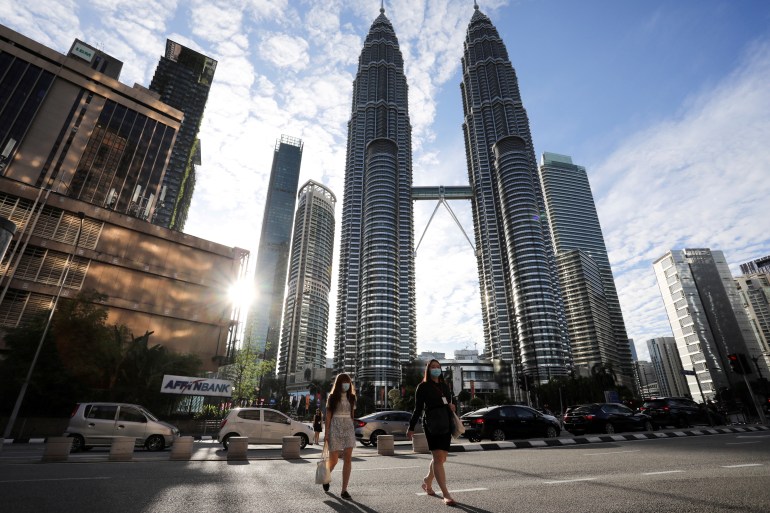For Malaysian tourism, decision on borders an anxious wait
The Southeast Asian country has yet to decide on reopening its borders after floating plans earlier this month.

Kuala Lumpur, Malaysia – More than two weeks after Malaysia proposed reopening its borders, the country’s tourism sector is anxiously awaiting a decision by the government to draw a line under two years of pandemic uncertainty and pain.
For award-winning travel agency Apple Vacations Sdn Bhd, business has been at a standstill since the borders closed in response to the emergence of the coronavirus in March 2020.
Keep reading
list of 4 itemsRussian billionaires see wealth tumble as tensions escalate
Tonga internet reconnected five weeks after volcanic eruption
Asian markets regain ground as investors hold breath on Ukraine
Group managing director Koh Yock Heng, better known as Kohsan, said sales had dropped 99 percent, with domestic tourism offering little respite for the outbound travel company.
“Our vaccination rates have shown improvements but with the sudden Omicron surge, the authorities will have to carefully study because it is important for us to be able to enter a new phase of living where we can start opening up the market with safe management measures in place,” Kohsan told Al Jazeera.
Health Minister Khairy Jamaluddin told reporters last week that borders were realistically only likely to reopen in the second quarter of the year, with the ministry preparing standard operating procedures (SOP) for lifting restrictions in the coming weeks.
The remarks came after a government advisory council chaired by former Prime Minister Muhyiddin Yassin on February 8 proposed the resumption of quarantine-free arrival for international tourists as soon as March 1.
Although hoteliers and tour operators welcomed the proposal, it received pushback from some politicians and public health experts concerned about the country’s surging Omicron wave.
Before a final decision is made, the SOP will be presented to the COVID-19 pandemic management committee chaired by Prime Minister Ismail Sabri and other relevant ministries, including the foreign ministry.
‘Negative economic effects’
Ming Luk Tan, head of Malaysia and Singapore business at OYO Hotels and Homes, said the industry had taken note of the fact that customers were prioritising safety, opting for stays in places with good ventilation and hygiene.
“While every country has to balance the economic need to welcome international travellers, there is nevertheless room to take caution and gradual approach through implementations of air bridges and travel bubbles rather than opening up the entire country all at once,” Ming told Al Jazeera, adding that his group’s revenues had plunged 60 percent during the pandemic.
Ming said it was questionable whether travel bans had much positive effect on public health at this point in the pandemic.
“While the negative economic effects of the interventions can be measured through financial performance indicators, the societal benefit of restricting international travel however has not been quantified,” he said.
However, Lim Chee Han, a public health expert and researcher with the Agora Society Malaysia, said authorities should consider maintaining quarantine measures to help control the virus.
“The government can review and revise this order after the Omicron-led pandemic wave has come down,” Lim told Al Jazeera, predicting that the surge would subside by May.
“The latest genome sequencing data reported until 28 January shows that 90.7 percent of Omicron variant cases found in Malaysia were imported,” Lim added, while noting that authorities only tested about 1,200 samples each month.

In the last week, authorities have reported an average of about 26,000 cases each day, with infections rising steeply.
Some European countries, including Denmark and the United Kingdom, have lifted practically all COVID-19 restrictions in recent weeks despite record caseloads. Currently, only Malaysians, permanent residents and a selected number of visa holders may enter the country, subject to strict testing and quarantine policies.
Malaysia’s Langkawi travel bubble has been an exception, while on February 16, the Malaysia-Singapore Vaccinated Travel Lane resumed with immediate effect. Talks are under way for travel lanes with Thailand and Indonesia.
Tourism is one of the driving forces of the Malaysian economy, with 26.1 million tourist arrivals in 2019 contributing RM86.1 billion ($20.6bn) in tourism receipts, according to the Department of Statistics. In 2019, tourism employed 3.6 million people, accounting for 23.6 per cent of total employment in the country. In the same year, the sector accounted for 15.9 percent of gross domestic product.
The Southeast Asian country received just 4.3 million tourists in 2020, an 83.4 percent decline from the previous year.
As the sector waits for the return of international visitors, some larger hotels and serviced residences like The Ascott Limited have refocused on the domestic market.
Country general manager Mondi Mecja said the group stayed afloat through its long-stay customer base and saw a significant rebound in business when the Malaysian government lifted its interstate travel bans in October last year.
“I think a lot of people will still be cautious about travelling especially when it comes to jumping on an aeroplane,” Mecja told Al Jazeera.
“We are still bound to domestic travel, or ‘Cuti-Cuti Malaysia’ or ‘Holiday in Malaysia,’ this year but with the opening of four new premises this year, we can expect a better recovery than originally forecasted.”